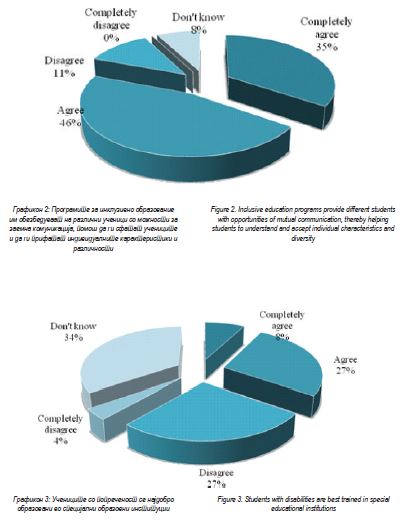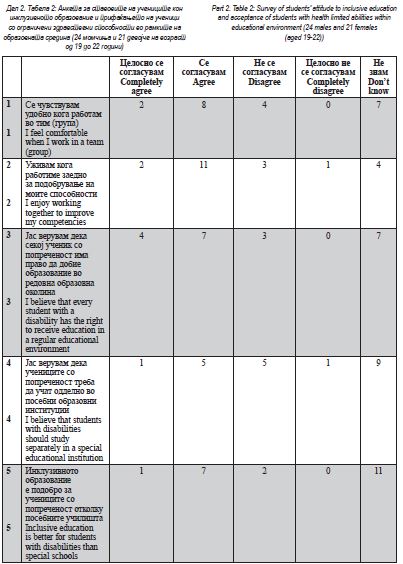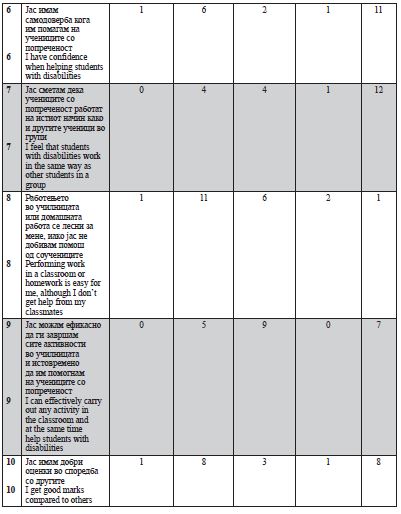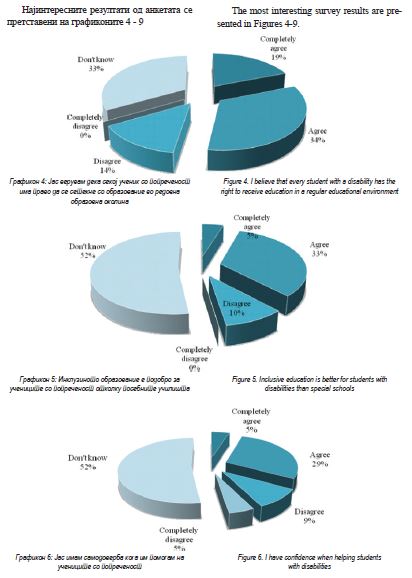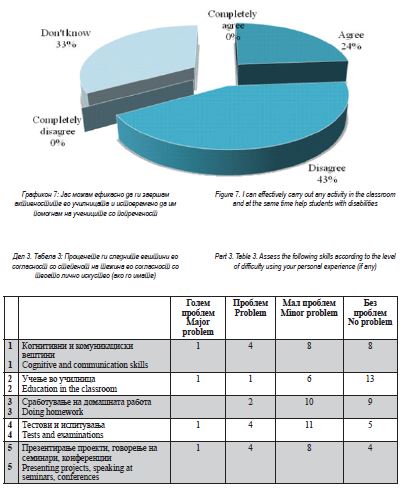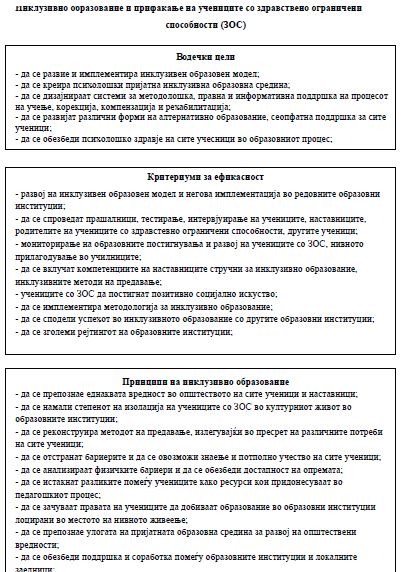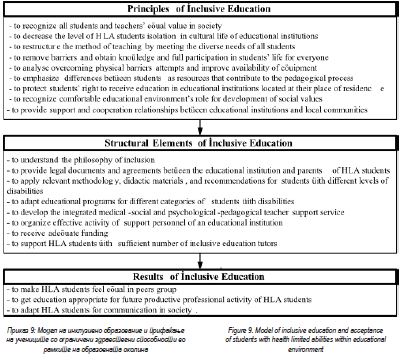JSER Policies
JSER Online
JSER Data
Frequency: quarterly
ISSN: 1409-6099 (Print)
ISSN: 1857-663X (Online)
Authors Info
- Read: 53740
|
МОДЕЛ НА ИНКЛУЗИВНО ОБРАЗОВАНИЕ И ПРИФАЌАЊЕ НА УЧЕНИЦИТЕ СО ОГРАНИЧЕНИ ЗДРАВСТВЕНИ СПОСОБНОСТИ ВО РАМКИТЕ НА УЧИЛИШНАТА ОКОЛИНА
Елена Александровна МАКАРОВА1 Елена Лвовна МАКАРОВА2 Оксана Александровна ХОЛИНА3 |
MODEL OF INCLUSIVE EDUCATION AND ACCEPTANCE OF STUDENTS WITH HEALTH LIMITED ABILITIES WITHIN EDUCATIONAL ENVIRONMENTElena Aleksandrovna MAKAROVA,1 Elena Lvovna MAKAROVA,2 Oksana AleksandrovnaHOLINA3 |
|
|
ВоведМодерниот свет се соочува со радикални промени во пристапот кон образованието и општеството и културната политика воо- пшто. Ова е поради ставовите на општест- вото за развој на индивидуалните квалитети кај личноста и интелектуалната еволуција. Дваесет и првиот век се карактеризира со сфаќањето дека само самореализацијата на личноста е главна цел во секој општествен развој. Овие промени во јавната свест водат до појава на нова парадигма во образова- нието, која е заснована на пристапите и кон- цептите развиени во модерните образовни практики.Тоаговклучуваособеноконцептот на „инклузивно образование“(1). УНЕСКО ја има дадено универзалната дефиниција за инклузивно образование како холистички феномен што укажува на една- ков пристап до квалитетно образование за сите деца без исклучок (2). Таа е заснована на хуманизам, развој на интелектуалните и креативните способности, баланс на инте- лектуалните, етничките, емоционалните и психолошките делови од личноста. Во процесот на историски развој, обра- зовниот систем за деца со ограничени здрав- ствени способности (ОЗС) премина од изо- лација во инклузија. Инклузивното образо- вание во Русија е во фаза на еволуција и се соочува со многу предизвици. Задачата за да се воспостави инклузивен образовен систем бара решение на владино ниво. Тоа е инклу- зија која им обезбедува еднакво образование на учениците со ОЗС, развој на вештините кои се неопходни за максимална адаптацијаи успешна интеграција воопштеството. Главниот услов за модерно образование е тоа дека треба да биде ориентирано кон личноста и да цели кон личен развој. Со овој пристап сите форми, модели, технологии на образованиеморадасезематпредвидвокон- текстот на главните задачи наобразованието, што значи обезбедување најповолни услови за сопствен развој и адаптација на општест- вената околина. Како резултат на тоа, обра- зованието се фокусира на помагање на лич- ниот развој и збогатување на личноста, како и дефинирање на социјалната улога на лич- носта во надворешниотсвет. Дисеминацијата на инклузијата во Руската Федерација не е само рефлексија на модерните трендови во светот, туку ја прет- ставува имплементацијата на правото на лицата со попреченост за еднакво образо- вание заедно со и покрај нивните врсници во редовните образовни институции, во согласност со законодавството во Руската Федерација. „Инклузивното образование може да се дефинира како инклузија на сите деца и млади лица без оглед на нивните индивидуални разлики, вклучителнонивната раса, етничка припадност, попреченост, пол, сексуална ориентација, јазик или социоеко- номски статус“(3). Инклузивната пракса вклучува подобру- вање на квалитетот на живот на одредени ученици без да се наруши квалитетот на живот на другите учесници во образовниот процес и создавање неопходни услови за успешна социјална адаптација и образова- ние за сите ученици без исклучоци, без оглед на нивните индивидуални психички или физички попречености, образовни достигну- вања, јазик, култура, религија итн. Главните цели на образовните институ- ции во имплементирањето на инклузивните практики се: • развој и имплементација на модел на инклузивнообразование; • создавање психолошки удобна инклу- зивна образовнаоколина; • дизајнирање системи на методологија, нормативна и информативна поддршка во процесот на учење, корекција, ком- пензација ирехабилитација; • развој на различни форми на алтерна- тивно образование, сеопфатна поддрш- ка за ситеученици; • да се осигура психолошкото здравје за сите учесници во образовниотпроцес.
Прифаќањето на учениците со тешкотии во конвенционалните одделенија, како дел од пристапот за образовна инклузија, е пре- порака од Комитетот на ЕУ за деца и млади лица за земјите членки(4). Главните структурални елементи во мо- делот на инклузивно образование во конвен- ционалните образовни институции вклучува: • филозофија заинклузија; • правни документи и договори помеѓу образовните институции и родителите, вклучувајќи ги сите неопходни услови за образование за учениците со попре- ченост, вклучувајќи ги и барањата за семејството; • достапност на значаен методолошки развој и препораки засновани на прис- тапот способности-активности за уче- ниците со различни нивоа на попрече- ност; • достапност на адаптирани образовни програми за различни категории науче- ници сопопреченост; • дидактичкиматеријалииметодизапре- давање; • професионален развој на наставниците во инклузивното образование, специја- листи од интегрирани медицинско-со- цијални и психолошко-педагошкиуслу- ги заподдршка; • организација на ефективни активности за персоналот за поддршка во рамките на една образовнаинституција; • архитектонска трансформација,вклучи- телно и околина безбариери; • соодветнофинансирање; • доволен број тутори за инклузивно об- разование за придружба и поддршка на ученицитесопопреченост,поддршкаод тутор(5).
Туторите се лица кои се фокусирани на создавање и имплементација на личниедука- тивни стратегии кои ги земаат предвид лич- ните потенцијали на една личност, образов- ната и социјалната инфраструктура и целите на главните активности(6). За време на последната декада беа напра- вени неколку напори во одделни европски земји, како што се Босна и Херцеговина (7), Хрватска (8), Грција (9), Турција (10) и Португалија (11), за обезбедување инклузија во образованието. Во Шпанија, учениците со посебни потреби се образуваат во редовни училишта кога е тоа можно, во согласност со принципите за нормализација и сегментали- зам, во училиштата коишто се најблиску до нивното место на живеење(12). Значајноста на темата за инклузија е прикажана преку статистички податоци. Согласно со Министерството за образование и наука на Руската Федерација, 450 илјади деца со тешкотии учат за руските училишта, од кои само 15 илјади го продолжуваат нив- ното образование на универзитет. Согласно со Министерството за здравство и соција- лен развој на Руската Федерација, повеќе од половина од сите ученици со попреченост (55.98%) се со интелектуална попреченост или попреченост за учењето, 30.07% сонару- шување за однесувањето/личноста, 10.94% со ограниченост на физичките активности, 3.63% со повеќе попречености, 6.71% со нарушување на слухот, 2.89% со нарушу- вање на видот и 1.17% со други здравствени проблеми (13). Секој единаесетти жител за Руската Федерација има некоја форма на попреченост. Тоа се 13 милиони луѓе со раз- личнифизички,психичкиилиинтелектуални попречености на различен степен: вродени или стекнати нарушувања на мускулно-ске- летниот систем, видот, слухот, менталната состојба, нарушување за однесувањето и други здравствени проблеми. Повеќето од нив имаат потреба од специјално адаптирани услови за живеење и учење и често имаат потреба од помош од други лица. Затоа, уло- гата на туторите за инклузивното образова- ние е толкузначајна. МетодиПредметот на ова истражување е да се откријат ставовите на наставниците, роди- телите, другите ученици и персоналот за поддршка за инклузијата како феномен и Учениците со ОЗС за редовните училници. Алатки на истражувањето се прашал- ници, тестови и интервјуа со ОЗС родители, наставници,ученицииперсоналзаподдршка со цел да се идентификуваат проблемите и да се помогне за создавањето психолошки удобна образовна околина за Учениците со ОЗС. Посебно создаден прашалник беше користен како алатка за набљудување. Анкетата се состоеше од различни тестови за сите учесници за образовниот процес. Основните истражувачки методи вклучуваат (1) анкета на учениците, (2) анкета на наставниците, (3) анкета на пер- соналот за поддршка и (4) квантитативна и квалитативнаанализанарезултатитеоданке- тата. Истражувачкиот метод за набљудување беше исто така употребен за време на експе- рименталната фаза на истражувањето. Видот на оваа истражувачка студија е психолошко (анонимно) набљудување. Целта на анкетата е да се проучат мислењата на учениците, родителите, наставниците и персоналот за поддршка за образованието на Учениците со ОЗС во рамките на редовнитеучилници. ПримерокАнкетата вклучува 50 ученици: 24 мом- чиња и 26 девојчиња на возраст од 19 до 22 години. Ние го поделивме примерокот на две групи. Во првата група беа 50 ученици од Институтот Таганрог со назив „А. Чехов“. Другата група се состоеше од 45 ученици на возрастод19до22години,итоа24момчиња и 21 девојче. Различен прашалник им беше понуден на наставниците, туторите и персо- налот за поддршка во Институтот.
Резултати
|
IntroductionThe modern world is experiencing a radical change in approaches to education and to social and cultural politics in general. This is due to the attitudes of the society to development of an individual’s personal qualities and intellectual evolution. The 21st century is characterized by theunderstandingthatonlypersonality’sself-ac- tualization is the main goal of any social devel- opment. These changes in the public conscious- ness led to the emergence of a new paradigm of education, which is based on the approachesand conceptsdevelopedbymoderneducationalprac- tices. These include, in particular, the conceptof “inclusive education” (1). UNESCO has given the most universal defi- nition of inclusive education as a holistic phe- nomenon that implies equal access to qualityed- ucation for all children without exception (2). It is based on humanism, intellectual and creative ability development, balance of intellectual, eth- nic, emotional and physiological fractions of personality. In the process of historical development, the educational system for children with health limited abilities (HLA) has gone from isolation to inclusion. Inclusive education in Russia is at the stage of evolution, facing a lot ofchallenges, thereforethetaskofestablishinganinclusiveed- ucation system requires solution at the govern- mental level. It is inclusion that provides HLA studentswithequaleducation,withdevelopment of skills necessary for maximum adaptation and successful integration intosociety. The main requirement for modern education is that it should become person oriented and be aimed at personal development. With this ap- proachanyforms,methods,technologiesofedu- cation must be considered in the context ofmain tasks of education – ensuring the most favorable conditions for self-development and adaptation to social environment. As a result, educationhas become focused on helping a person develop and enrich personality and define a person’s so- cial role within the outside world.Dissemination of the inclusion in the Rus- sian Federation is not only a reflection of mod- ern trends in the world but it represents the im- plementation of impaired students’ rights to get equal education along with and alongside of their peers in mainstream educational institutions in accordance with the legislation of the Russian Federation. “Inclusive education can be defined as the inclusion of all children and young people regardless of any individual differences, includ- ing race, ethnicity, disability, gender, sexual ori- entation, language, or socioeconomic status” (3). Inclusive practice involves improving a par- ticular student’s quality of life without impairing the quality of lives of other education process participants, and creating the necessary condi- tions for social adaptation success and education for all students without exception, regardless of their individual mental or physical disabilities, educational attainment, language, culture, reli- gion, etc. The leading objectives of an educational in- stitutioninimplementinginclusivepracticesare: • to develop and implement an inclusive ed- ucation model, • to create psychologically comfortable in- clusive educational environment, • to design systems of methodological, nor- mative and informational support of the learning process, correction, compensation and rehabilitation, • to develop various forms of alternative education, comprehensive support for all students, • to ensure psychological health of all par- ticipants of the education process. Acceptance of students with disability in mainstream classes as a part of an educational inclusion approach has been recommended by the Committee of the European Union for chil- dren and young people of member states (4). The main structural elements of the inclu- sive education model in a mainstream education institution include: • philosophy of inclusion, • legal documents and agreements between the educational institution and parents, including all the necessary conditions for education of a student with disabilities, in- cluding the requirements for thefamily, • availability of relevant methodological de- velopments and recommendations based on the competence-activity approach for students with different levels of disabili- ties; • availability of adapted educational pro- grams for different categories of students withdisabilities, • didactic materials and methods of teach- ing, • professional development of teachers of inclusive education, specialists of the in- tegrated medical-social and psychologi- cal-pedagogical supportservice, • organization of effective activity of sup- port stuff of an educationinstitution, • architectural transformations, including barrier-freeenvironment, • adequate funding, • sufficient number of inclusive education tutors to accompany and support students with disabilities, tutor support(5). Tutors are people focused on the construc- tion and implementation of a personal educa- tional strategy that takes into account the per- sonal potential of a person, educational and social infrastructure and the objectives of the main activity (6). During the last decade efforts have been made in several European countries, such as BosniaandHerzegovina(7),Croatia(8),Greece (9), Turkey (10), and Portugal (11), to facilitate inclusion in education. In Spain, students with special needs are educated in regular schools whenever possible, in accordance with the prin- ciples of normalization and sectionalism, at the school closest to where they live(12). The relevance of the topic of inclusion is shown by statistics. According to the Ministry of Education and Science of the Russian Federation, 450 thousand children with disabil- ities study in Russian schools, of which only 15 thousand continue their education at colleges and universities. According to the Minister of Health and Social Development of the Russian Federation, more than half of all students with disability (55.98%) are with an intellectual or a learning disability, 36.07% with behavior/per- sonality disorder, 10.94% with a physical activ- ity limitation, 3.63% with multiple disability, 6.71% with hearing impairments, 2.89% with visual impairments, and 1.17% with otherhealth conditions (13). Every eleventh resident of the Russian Federation has some form of disabil- ity. These are 13 million people with features of physical, mental or intellectual impairment of various degrees: in-born or acquired disorders of the musculoskeletal system, vision, hearing, mental state, behavior disorder and other health conditions. Most of them need specially adapted living and learning conditions and often require other people’s help. That is why the role of tutors in inclusive education is soimportant. MethodsThe subject of our study is to figure outedu- cational institution teachers, parents, other stu- dents and support stuff’s attitudes to inclusion as a phenomenon and HLA students in main- streamclassrooms. Research tools are questionnaires, tests and interviews with HLA parents, educational insti- tution teachers, students and support stuff in order to identify problems and to help create psychologically comfortable educational envi- ronment for HLA students. Aspecially designed questionnaire was used as a monitoring tool. The survey consists of different tests for all the participants of the educational process. Basic research methods include (1) stu- dents survey, (2) teachers survey, (3)support stuff survey and (4) quantitative and qualitative analysis of survey results. Research method of monitoring was also used during the experimen- tal phase of the research. The type of this moni- toring study is psychological (anonymous)mon- itoring. The purpose of the survey is the study of the opinions of students, parents, teachersand support stuff about education of HLA students in the mainstream classroom. SampleThe survey involved 50 students: 24 male and 26 female aged 19-22. We divided the sam- ple in two groups. The first group consists of 50 students of Taganrog Institute named after A. Chekhov. Another group consists of 45 students (aged 19-22): 24 male students and 21 female students. A different questionnaire was offered to teachers, tutors and support stuff of the same Institute.
Results |
|
|
||||||||||
|
|
|
|||||
|
the model of inclusive educationandacceptance ofstudentswithhealthlimitedabilitieswithineducationalenvironment,whichmakesaprac- tical contribution to the basic scientificresearch. The society should provide any person with the free choice of the type of education, depend- ing on interests, needs, and opportunities. The diversity of proposals in the field of education should be provided (22). There is no doubt that thedifficultiesarethegreater,themorecomplex the structure of society, the more pronounced social differentiation and social stratification. Without a competent solution of HLA students problem, without eliminating the practices of infringingon the constitutional rights of people DiscussionThe basis of inclusive education is that educational institution should take all students’ needs into account the, not that students should comply and fit within the frameworks estab- lished by the institution. Before inclusion was introduced to Russian education there had been integrated education, which was enshrined in the Standard Rules and the process of teaching disabled children in ordinary schools was called “integrated education”. But the community of HIAstudents,theirparentsdidnotreallylikethe idea of integrated education. Because it rather meant: there is a sick person, he is different, not like everyone else, and there is a mainstream society, and this sick person needs to be some- how integrated into this mainstream society. While inclusive education means that all peo- ple are different, and each one is special in his\ her own way, but all of them belong to the same particular community. And all of them (gifted, non-Russian-speaking, talented or disabled) have the same right to get education and to hope for a better future. It can be said that the transition period to joint training of different categories students in Russia has the right basis. Unfortunately, the majority of positive moments presented in the laws still remain only on paper. As in many pro- gressive legislative acts, there is practically no mechanism for legislative acts implementation into teaching practice. Besides, there is a certain bias towards inclusive education in society (24). In a number of cases, the problem is related to teaching materials lack and technical unwill- ingness of the institutions of mainstream educa- tion to teach children with developmental dis- abilities, for which smaller classes are required (from 6 to 12 people), adapted to their special psychophysical opportunities training programs, special didactic, correctional-developing equip- ment,sometimesatutor,whowouldbeassigned to a student and would assist in the classroom and with the homework. In addition,educational institutions should be sufficiently staffed with highly qualified personnel, who would contrib- ute to a more complete satisfaction of educa- tional needs and social integration of children and adolescents with developmental or behav- ioral disabilities, the optimal implementation of social and psychological programs, psychologi- cal and medicalsupport. ConclusionThus, the problem of inclusive education is complex, debatable, but the main thing is that it is truly social, since by its solution the inter- ests of a huge number of people are affected. The society should provide any person with the right choice of the type of education, depending on his\her interests, needs and opportunities. The reisnodoubtthat the difficulties are the greater, the more complex the structure of soci- ety, the more pronounced social differentiation and social stratification. Without a competent solution to this problem, without eliminating the practices of infringing on the constitutional rights of people with developmental disabilities, degrading their dignity, or manifestations of social discrimination, Russia will not become a civilizedstate. Although to launch inclusive education program at the educational institution it is nec- essary to develop a methodology aimed at HLA students, to provide teachers with special knowledge and skills to deal with students with disabilities, to equip institution with ramps, lifts and access to other places, but it is also neces- sary to develop teachers, students and support stuff’s awareness and attitudes towardsconcepts of inclusion and inclusive education model. It is also important at the level of value attitude to co-education that all employees of educational institution, students, their parents and attendants accept ideas of inclusive education.
Conflict of interestsAuthors declare no conflict of interests.
Source of FundingThe study was carried out with the financial support of the Russian Foundation for Basic Research in the framework of the research proj- ect “Understanding the Socio-Philosophical Phenomenon of Educational Inclusion in the Context of Foreign and Domestic Methodological Approaches and Models”, No. 19-013-00117 \19 |
||||
References1. Makarova E.A. Socio-pedagogical aspects of inclusive education. Actual problems of special and inclusive education of children andyouth.TaganrogInstitutenamedafter A.P. Chekhov («RSEU»), Taganrog, 2019. - 342 p. 2. A Guide for ensuring inclusion and equity ineducation.UNESCO.AssistantDirector- General for Education, 2010-2018 (Qian Tang). 2017, 46p. 3. Polat, F. Inclusion in education: A step towards social justice. International JournalofEducationalDevelopment,2011. 31(1), 50–58. doi:10.1016/j. ijedudev. 2010.06.009 4. Council of Europe - Highlights 2013 (2014), Guardian of human rights, democracy and the rule of law. Activity report.PublishedbytheCouncilofEurope, Strasbourg Cedex,2014. 5. Makarova E.A. Individual educational trajectories as a means of forming a psychologically comfortable environment for inclusive education. University Psychological Service: Reality and Perspective. - Moscow: Moscow State Pedagogical University, 2017, pp. 188 -195. 6. Kuzmina E.V. Tutor profession ininclusive practice. Inclusive education: practice, research, methodology: Proceedings of the II International Scientific and Practical Conference / Resp. ed. Alekhina S.V. М., 2013. 7. Dizdarevic A, Mujezinovic A,Memishevic H. Comparison of teachers’ attitudes towards inclusive education in Bosnia and Herzegovina and European Union. J Spec Educ Rehab 2017; 18(1-2):92-108. doi: 10.19057/jser.2017.21 8. Lisak N, Bratković D, Anić T. Experiences from the educational system – narratives of parents with children with disabilities in Croatia. J Spec Educ Rehab 2017; 18(3- 4):91-125. doi:10.19057/jser.2017.28 9. Panagiotou, A. K., Evaggelinou, C., Doulkeridou, A., Mouratidou, K., & Koidou, E. Attitudes of 5th and 6th grade Greekstudentstowardtheinclusionof children with disabilities in education program. European Journal of Adapted Physical Activity, 2008. 1(2), 31-43 10. Özer, Özlem et al. An evaluation on levels of knowledge, attitude and behavior of people. Afr J Tradit Complement Altern Med. (2013) 10 (1):134-141 http://dx.doi.org/10.4314/ajtcam.v10i1.18 11. Campos, M. J., Ferreira, J. P., &Block, M. E. Influence of an awareness program on Portuguese middle and high school students› perceptions of peers with disabilities. Psychological Reports, 2014. 115(3), 897-912. 12. Peetsma, T. Inclusion in Education: Comparing pupil›s development in special and regular education. Educational Review, 2001. 53, 125-136. 13. Inclusive education in Russia and Moscow. Statistics and reference materials [Online]. 2009 [Cited 2019 Jul]. Available from: URL:https://dislife.ru/articles/view/4696 14. Reina, R., López, V., Jiménez, M., García-Calvo, T., & Hutzler, Y. Effects of awareness interventions on children’s attitudes toward peers with a visual impairment. International Journal of Rehabilitation Research, 2011. 34(3), 235-242. 15. Triandis, Harry C. Attitude and attitude change. New York: John Wiley & Sons, Inc., 1971, 232 p. 16. Hutzler, Y. Attitudes toward the Partici- pation of Individuals with Disabilities in Physical Activity: A Review Quest, Volume 55, 2003 - Issue 4, pages347-373. 17. Block,M.E.Ateacher’sguidetoincluding students with disabilities in general physical education (3rd ed.). Baltimore, MD: Brookes.2007. 18. Janney, R., & Snell, M. E. (2006). Social relationships and peer support (2nd ed.). Baltimore, MD:Brookes. 19. Pace, D. Increasing awareness and under- standing of students with disabilities. Aca demic Exchange Quarterly, 2003. 6,28-34. 20. Kozyreva O.A. Inclusive educational environment creation as social and pedagogical problem. TGPU Herald, 2014, #1, pp. 112-115 21. Khalimova N.M., Naydanova O.C. Peculiarities of social adaptation of HIA children within inclusive education environment. KGPU Herald named after Astafiev V.P., 2014, #3 (29),pp.127-130. 22. Ionin, L.G. Sociology of culture: studies. Textbookl for universities. State Univ.of Economics. —4 th ed., - M: Higher School of Economics, 2004. - 427с. 23. Hunt, P., Soto, G., Maier, J., & Doering, K. Collaborative teaming to support students at risk and students with severe disabilities in general education classrooms. Exceptional Children, 2003. 69,315-332. Russell, D. Illusion of inclusion: Realities and consequences. Paper presented at the International Conference on Education and Deafness (ICED), June 2010, Vancouver, Canada. 2010 |
||
Share Us
Journal metrics
-
 SNIP 0.059
SNIP 0.059 -
 IPP 0.07
IPP 0.07 -
 SJR 0.13
SJR 0.13 -
 h5-index 7
h5-index 7 -
 Google-based impact factor: 0.68
Google-based impact factor: 0.68
10 Most Read Articles
- PARENTAL ACCEPTANCE / REJECTION AND EMOTIONAL INTELLIGENCE AMONG ADOLESCENTS WITH AND WITHOUT DELINQUENT BEHAVIOR
- RELATIONSHIP BETWEEN LIFE BUILDING SKILLS AND SOCIAL ADJUSTMENT OF STUDENTS WITH HEARING IMPAIRMENT: IMPLICATIONS FOR COUNSELING
- EXPERIENCES FROM THE EDUCATIONAL SYSTEM – NARRATIVES OF PARENTS WITH CHILDREN WITH DISABILITIES IN CROATIA
- INOVATIONS IN THERAPY OF AUTISM
- AUTISM AND TUBEROUS SCLEROSIS
- THE DURATION AND PHASES OF QUALITATIVE RESEARCH
- REHABILITATION OF PERSONS WITH CEREBRAL PALSY
- DISORDERED ATTENTION AS NEUROPSYCHOLOGICAL COGNITIVE DISFUNCTION
- HYPERACTIVE CHILD`S DISTURBED ATTENTION AS THE MOST COMMON CAUSE FOR LIGHT FORMS OF MENTAL DEFICIENCY
- DIAGNOSTIC AND TREATMENT OPTIONS IN AUTISTIC SPECTRUM DISORDERS – AN OVERVIEW













